4.4: Variation and evolution
Variation
Variation is differences within a phenotype.
This is heritable if it results from DNA nucleotide sequences, or in some cases epigenetic modification (the study of how behaviour and the environment can change the way your genes work), can be inherited by offspring.
Variation imposed that the environment that is not epigenetic cannot be transferred to offspring and is non-heritable.
This could be factors such as malnutrition.
In asexual organisms, heritable variation is only increased by mutations, while sexual reproduction has many different mechanisms:
Crossing over during homologous chromosomes during prophase 1 of meiosis.
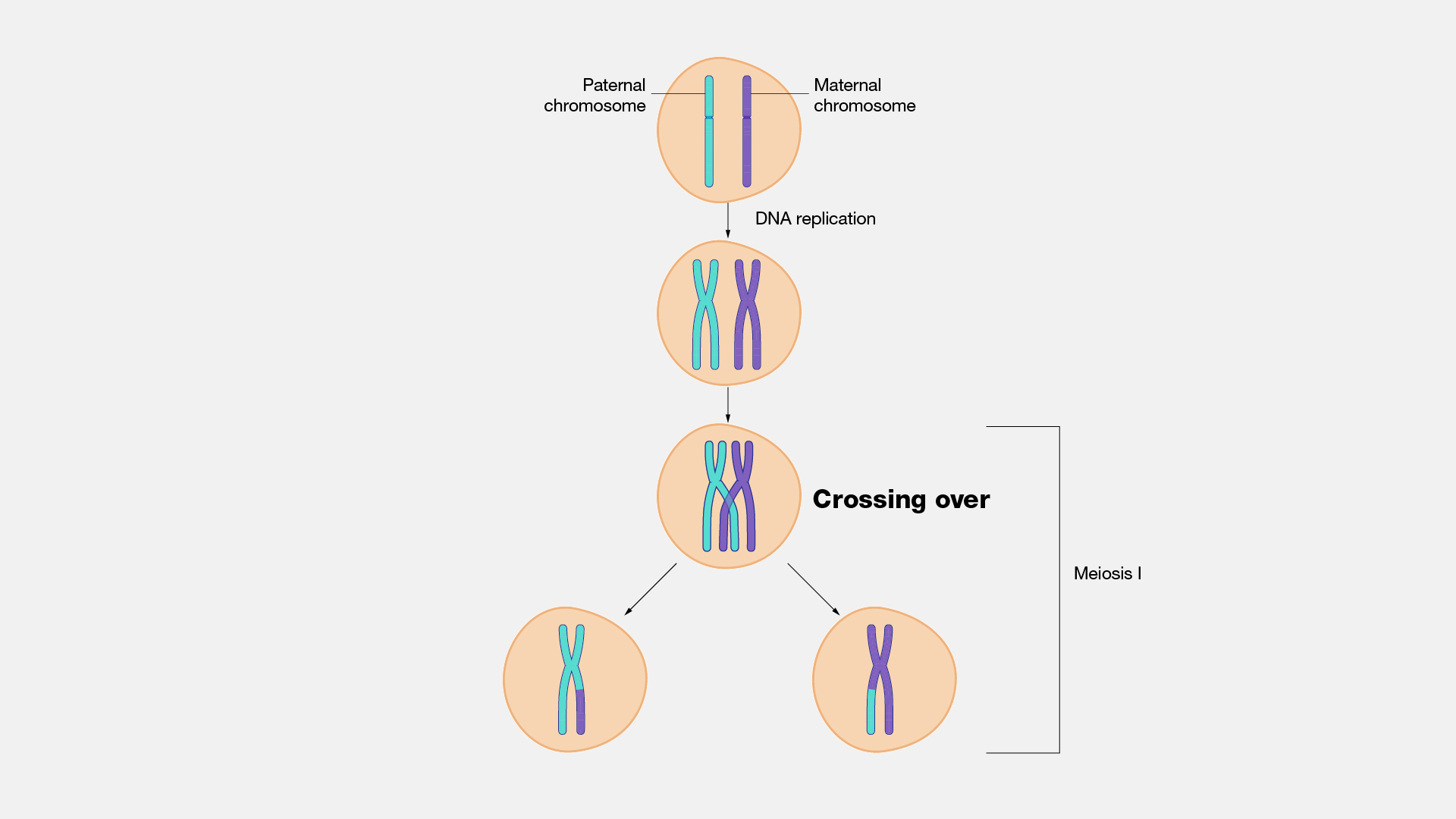
Random distribution of chromosomes during metaphase 1 of mitosis.
Random distribution of chromatids at metaphase 2 of meiosis.
Mixing of two parental genotypes at fertilisation.
These processes establish a new combination of alleles, but only the rare mutation generates long lasting novel variation.
There are two types of variation:
Discontinuous variation
This is when there is only a small amount of variation of a characteristic, with no intermediate types and characteristics that are discrete.
These characteristics are controlled by single genes, and therefore are monogenic.
The environment has no influence on these genes.
Examples are:
Dwarf or tall plants, speckled or dark peppered moths, blood types, etc.
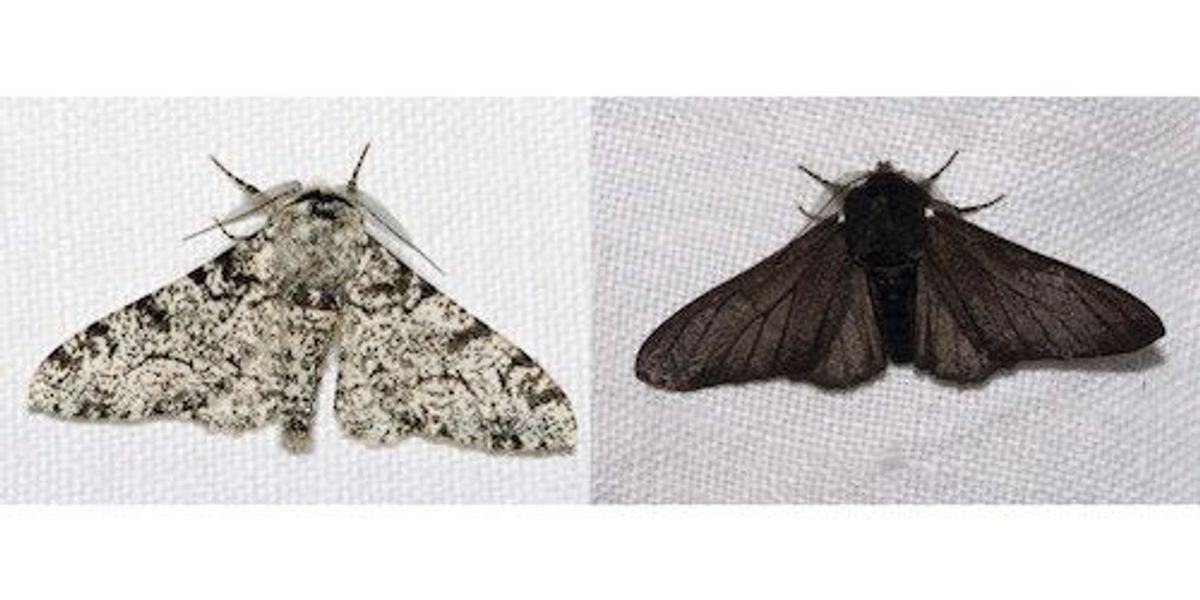
Continuous variation
This is when characteristics have many possible values, which usually show a normal distribution from one extreme to another.
This is controlled by many genes and therefore referred to as polygenic.
The environment has considerable impact on the expression of their gene, and therefore determining phenotypic (the observable trait) variation.
Examples are:
Human height, with individuals inheriting a number of alleles which contribute to their height.
If they have the potential to grow tall, alleles determine the maximum size, but whether this is achieved is dependent on environmental factors such as nutrition and exercise.
Plant growth, with it’s potential determined by alleles but ultimately the final height determined by the environment.
For example, without light auxin (a plant growth hormone) synthesis elongating stem cells, preventing them from synthesising chlorophyll, causing chlorosis.
This occurs as auxin causes shaded parts of shoots to grow faster, allowing the shoot to bend towards the light.
If seeds germinate in the dark, the seedling is etiolated, it shows chlorosis and grows taller than if in the presence of light.
Organisms of identical genotypes can have considerable changes when subject to different environmental conditions
For example, strawberries made from asexual reproduction show height variation in response to light intensity, or growth direction in response to light direction.
Competition
Environmental resistance is necessary to prevent overproduction, which is cause when two parents have more than two offspring, so the population grows over time.
Most situations have limits to this growth, such as limits to resources which causes competition. For plants, this includes light, soil, water and mineral ions. In animals, this includes food and shelter.
This causes fewer offspring to be produced, or to die before maturity, and so avoid reproducing.
There are two types of competition:
Intraspecific - Between members of the same species, such as mates and nesting sites.
Interspecific - Between members of different species, such as food and water.
Selection pressure
Variation within a population means some individuals will have advantageous characteristics. These advantages allow them to gain access to limited resources easier, and therefore reproduce more.
Darwin referred to this as a ‘struggle for existence‘.
An example is in rabbits:
They rapidly reproduce, and if all of these survived (several litters a year, 2-10 babies) and reproduced, the population would grow rapidly, causing food supplies to deplete.
Rabbits that are better able to find this, for example having a better sense of smell, will be better able to find food and therefore survive.
They would then be able to reproduce more, and the alleles that gave them an advantage will be passed on.
These alleles are then referred to as ‘selected for‘, and food referred to as the selective agent or selection pressure (latter is better term).
This is therefore an example of natural selection.
Many environmental factors can act as selective pressure, and often phenotypes that allow for adaptability in harsh conditions are ‘selected for‘.
Examples of selective agencies include:
Nesting site availability - Some animals need specific situations to raise young, for example crows building nests 10-20 cm off the ground.
Day length affects reproductive behaviours - Female rabbit pregnancies occur in May, after the enlargement of the male testes which begins in November due to the short days.
Overcrowding causing disease spreading - Tuberculosis is more common in densely populated places, and therefore those with better immune systems are more likely to survive and pass on their alleles.
Predation - When prey population grows, predators have more food and their population increases. Prey who are better able to escape then reproduce and pass on those alleles. Examples are:
Camouflage can increase survivability, such as peppered moths camouflaged by soot on trees.
Mimicking toxic species, such as the Mexican milk snake mimicking the highly toxic Texas coral snake with it’s red, black and yellow markings.
Temperature - Mosquito larvae survive best in water that is between 24 and 28 degrees. Wolverines require heavy snowfall, as they dig their dens beneath soil and their cubs emerge developed enough at May.
Human impact - Habitat loss has destroyed breeding grounds. For example, sea turtles hatch on land and need a dark night sky to orient themselves, but artificial lights disorient them and they move away from the sea.
A way of remembering these if asked for an example is PANDA PAW:
Predators.
Availability of resources.
Nutrient supply.
Disease.
Accumulation of waste.
Phenomena.
Abiotic factors.
Weather conditions.
Allele value depends on the environment
Phenotypes are determined by genotypes, and the phenotypes must be suited to particular environments.
The same allele can produce phenotypes that are suited to one environment, but not another.
White rabbits are more suited to survive in the Arctic, but more likely to die in non-snowy places. White rabbits are therefore rare in these areas, but common in the Arctic.
Selection pressure is an abstract concept that shapes population over time, acting in a consistent fashion.
It affects both reproductive and survival rates of an organism.
The term ‘fit‘ describes how likely an organism is to survive, reproduce and pass on alleles.
Selection pressure, which is exerted by the environment, allows the fittest to survive and increases the overall fitness of a population.
This selection pressure also determines the spread of alleles.
There are often multiple selective pressures acting at once, which combine with genetic drift and mutation to determine phenotypes.
Types of natural selection
Stabilising selection
This is when a characteristic showing continuous variation has a range of values, and selection pressure means the average phenotype has a competitive advantage.
The average population will maintain the same curve, but have a smaller standard deviation and a higher peak.
Therefore the average is the same, but the proportion of animals around the average increases.
Examples include:
Birth weight in humans.
Those two small lose heat faster and are more susceptible to infection, so they survive less.
Heavy babies struggle to leave the birth canal, and therefore survival less.
Therefore, babies of normal weight (3.5 kg) survive most.
Tail size in cats.
Short tails mess up cat’s balance.
Long tails drag on the floor.
Medium tails are best.
Fur length:
Long fur could cause overheating.
Short fur could cause freezing.
Medium fur is best.
Directional selection
In changing environments, extreme phenotypes can become advantageous.
Over generations, there is a shift in the average to the left or the right.
This changes the average, meaning speciation (phenotype is so different that mating between the original and new population will not form fertile offspring) can occur.
Examples include:
Small cichlid fish have predators suddenly introduced.
Those with larger fins faster, and therefore have a competitive advantage to escape predators.
Therefore, fin size increases rapidly.
Lizards have predators suddenly introduced.
Long, wiggly tails appear as snakes and scare predators.
This means this tail increases rapidly.
Disruptive selection
The average phenotype does not provide an advantage and is selected against.
Lower and higher values are selected, forming a bimodal curve with two peaks.
This changes the average, meaning speciation can occur.
Examples:
Coho salmon have large and small males.
Large males gain access to females via competition.
Small males gain access to females via sneaking.
Medium salmon have no advantage, and are therefore selected against.
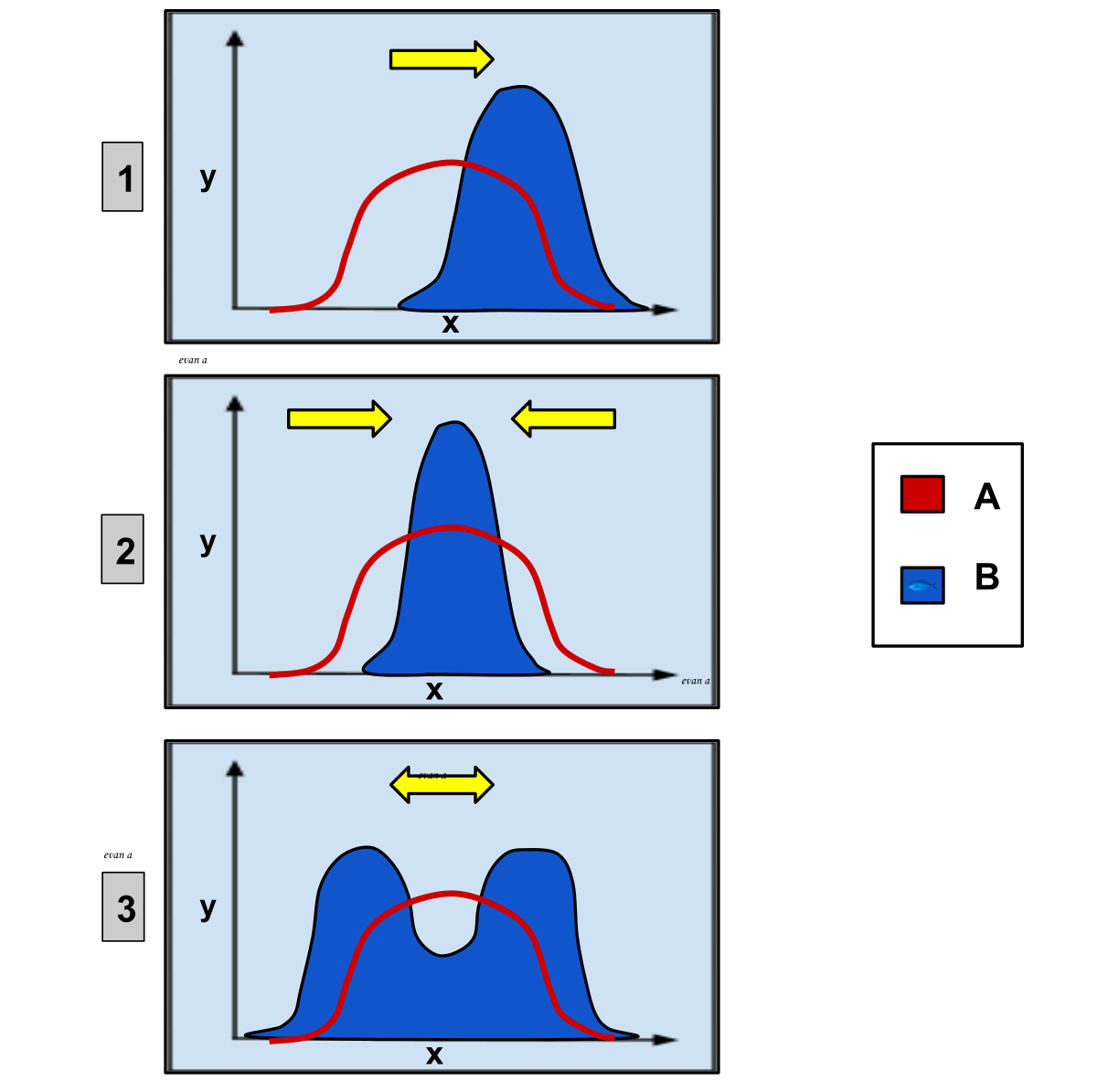
Genetic drift
Population genetics describes the behaviour of genes and alleles of an entire population.
Populations which sexually reproduce have variation.
This is not concerned with individual genotypes, but proportions of different alleles in the whole gene pool - allele frequencies.
All alleles within a population at one time make up the gene pool.
Genotypes are a selection of possible allele combinations.
Genetic drift is the chance variance in allele frequency:
This is more apparent in smaller populations.
For example, an allele in 1% of a large population is more likely to be passed on than 1% of a small population.
This could mean that this 1% all fail to reproduce, and the allele is completely lost in the gene pool.
It also occurs in isolated populations, where only a small number of alleles are in the gene pool.
In isolated populations which colonise a new area, they may have a very different allele frequency than the founding population.
This is known as the founder effect.
If it remains small, genetic variation between populations occurs easier.
Average phenotypes, and therefore alleles, can rapidly change.
A population bottleneck is a sharp reduction in population.
This therefore reduces the gene pool and the genetic diversity, which could mean the population is unable to adapt, causing extinction.
These effects contributed to the variation Darwin witnessed in the Galapagos islands.
Hardy-Weinberg principle
This states that in ideal conditions, allele and genotype frequencies within one population are constant throughout generations.
These conditions are:
The organisms:
Are diploid (2n).
Allele frequencies are consistent over sexes.
They sexually reproduce.
Mating is random.
Generations do not overlap.
The population:
The population is very large.
There is no migration.
There is no mutation.
There is no selective pressure.
The principle allows allele frequencies to be calculated from genotype frequencies.
p represents dominant alleles (A).
q represents recessive alleles (a).
Therefore p + q = all the alleles in a population.
When crossing Aa and Aa in a punnett square, the distribution is:
1 AA, 2 Aa, 1aa.
This is represented by the next formula:
p2 + 2pq + q2 = 1, as these are all the possible genotypes.
p2 represents the AA genotypes, 2pq represents the Aa genotype, and q2 represents the aa genotype.
This is the Hardy-Weinberg equation.
If this equation is true for a population and remains the same over populations, it is said to be in Hardy-Weinberg equilibrium.
T-test
This is a statistical test that shows whether a trait shows random distribution, or another factor.
A null and alternative hypothesis must be set up beforehand:
Null - There is no significant difference…
Alternative - There is a significant difference…
When asked in an exam to explain the results, accept one hypothesis and reject the other.
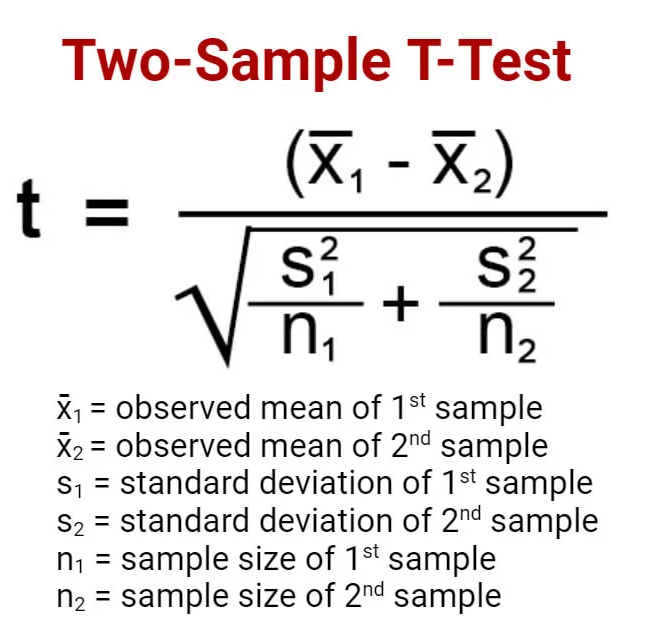
The test itself has three stages:
Calculate standard deviation for both data sets.
Calculate mean for both data sets.
Substitute figures into the formula, and either:
Type it into a calculator.
Type it in individual pieces.
Then, the T value is compared to the critical value, found in a critical value table:
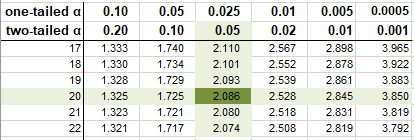
The critical value is found by lining it up with two categories.
The level of probability, the top column. This will always be 0.05%, as above this is classed as statistically significant.
The degrees of freedom, which is the sample number minus 1. As there will be two samples compared, it will be minus 2.
This critical value is then compared to the T value. If the T value is equal or above, it is significantly significant. The null is rejected, and alternative accepted.
If the T value is below, it is not statistically significant. The null is accepted and the alternative rejected.
Variation and evolution
A species is a group of organisms that can interbreed to form fertile offspring.
Sometimes it is difficult to tell whether species can interbreed, if they are:
Few in number.
Widely separated.
Only known as fossils.
Have a very long life cycle.
Only reproduce asexually.
In these cases, they are assumed to be in the same species if their physical characteristics are similar.
New species can occur via:
Abruptly, when chromosome number doubles due to endomitosis (cytokinesis not occuring), making a polyploidy organism.
This is rare, and happens more often in plants such as bread wheat.
Gradually, via isolation of species groups.
A population is an interbreeding group of one species.
Subgroups within this population may breed more often with one another than the rest of the population, known as demes.
If a deme becomes isolated, it cannot breed with other demes, so gene flow is prevented between demes.
The mechanism preventing gene flow is an isolating mechanism, and the groups are reproductively isolated.
If they are isolated for long periods of time, their allele frequency changes and they accumulate different mutations they are no longer able to interbreed with the initial population.
This is speciation, and they now have separate gene pools.
Sometimes demes can still interbreed after many phenotypic differences, but often after long times separated this is not possible.
Reproductive isolation can be:
Pre-zygotic - Gametes are prevented from fusing - no zygote is ever formed.
Post-zygotic - Gametes fuse and a zygote can form. However, even if the zygote develops and grows, it is sterile, meaning the genes of the parent species are kept separate and the species cannot merge.
Pre-zygotic isolation
Geographical isolation
This occurs when a physical barrier separates demes.
This can be a mountain, river, desert, etc.
When demes are in different areas, speciation is allopatric.
For example:
Birds that need a cool environment move higher up the mountains in the warmth, and are separated into demes by the different mountains.
On these mountains, there are different selection pressures, so the demes change, such as beak size for different foods.
When the temperature reverts, the birds return down the mountain, but due to their different beaks they make different mating calls, preventing interbreeding.
Therefore, there are now two separate species.
Behavioural isolation
Many animals have different mating rituals and courtship displays that other members of the species recognise, meaning they will only breed if these rituals are fulfilled.
As they share a habitat, this is sympatric speciation.
For example:
Male grasshoppers make a song recognised by females, and they then reproduce.
Only in lab conditions, where the specific song is played over a different type of grasshopper, will these groups interbreed.
Therefore, in the wild they form two separate breeding groups, which over time would likely accumulate other differences which would prevent successful interbreeding, causing speciation.
It has also been suggested this was what caused Homo sapiens and Homo neanderthalis to be two separate species - different mating behaviour.
However, it was not always successful, as modern humans have 1-4% H.neanderthalensis genes.
Morphological isolation
This is when animals develop a structural barrier to mating.
This is sympatric speciation.
For example:
Insects, which have rigid exoskeletons which means male and female genitalia must be compatible for offspring to be formed.
This is sympatric speciation, as they live in the same environments.
This can also happen in plants, such as the star orchid, which has a deep nectary which only the Madagascan sphinx moth can reach due to it’s long mouth part.
This means it only has one pollinator, and therefore is isolated from other orchids.
Gametic isolation
Gametes in open environments can meet gametes of other species.
Barriers prevent the fusion of gametes between species, isolating the population.
These than accumulate mutations, undergoing speciation.
This is sympatric speciation.
For example:
There are molecules in gamete membranes to prevent fusion.
Chemo-attractants secreted by females are only recognised by males.
Angiosperm pollen can germinate on the stigma, but only form a small pollen tube which is unable to reach the ovule.
Sperm of some species does not survive in an oviduct.
In coral reefs, gametes are released at the same time. A third of these form interspecies hybrids, and the rest are incompatible.
Seasonal isolation
AKA temporal isolation.
Reproductive organs of different demes mature at different times, preventing hybridisation.
This is sympatric speciation.
For example:
The creeping buttercup and the lesser celandine are prevented from interbreeding as one flowers in June, and one in April.
Post-zygotic isolation
Hybrid inviability
Fertilisation of gametes can occur, but gene incompatibility prevents embryo development.
For example:
Northern leopard frog and wood frog offspring only survive for a day.
Hybrid sterility
When an embryo can develop, but chromosomes are not similar enough to pair at prophase 1 of meiosis, which prevents meiosis from occurring.
This means the hybrid is sterile.
Gene flow can therefore not occur between the species, so they remain distinct.
For example:
Mules are a hybrid between a female donkey and a male horse, the converse is a hinny.
They are both sterile, as a horse provides 32 chromosomes in its gametes, and a donkey provides 31. The chromosomes of a mule are therefore unable to make homologous pairs, making them sterile.
Cordgrass can undergo endomitosis on rare occasions, which means the chromosome number doubles.
This means pairing at mitosis can happen, and the hybrid is fertile.
Bread wheat ancestry has been studied by looking at it’s relatives, such as wild grasses.
It was concluded that repeated hybridisation and endomitosis produced hexaploid wheat.
Hybrid breakdown
This is when the first generation of offspring are fertile, but the second generation is sterile.
This most common in plants, such as cottom, legumes and rice.
It is suspected to be caused by incompatibility between nuclear genes, genes in the mitochondria and chloroplasts.
Darwinian evolution
Before Darwin, there were many ideas around how species changed.
Lamarck was the first comprehensive theory, known as the transmutation of species in 1815.
He believed animals acquired changes based on want or need, and these were transmitted to offspring.
For example, an giraffe stretches to reach the highest leaves in a tree, and it’s offspring suddenly have a long neck.
The drive for change was known as orthogenesis, and the sudden large mutations as saltationism.
Around the 1920s Darwin and Wallace’s ideas became accepted.
By the 1930s, Mendelian genetics was rediscovered and integrated with Darwinism.
Evolution can be brought about by:
Mutation.
Gene flow.
Genetic drift.
Natural selection.
Darwin made his observations on the HMS Beagle, a scientific survey ship, which travelled to the Galapagos islands.
Darwin observed:
Resources are limited.
Individuals produced a large number of offspring, yet the numbers of adults through generations remained the same.
The population has variance in appearance and behaviour.
He then concluded (additions with a modern understanding of genetics):
There is a struggle for existence, and only the ‘fittest‘ survive (Spencer labelled this survival of the fittest in 1864).
Survivors have a competitive advantage, with a better adapted phenotype developed by a random mutation.
These survivors are able to reproduce more successfully, and their alleles are passed on to their offspring.
These offspring then also have this competitive advantage.
This continues until these alleles increase in proportion across the population, therefore the average phenotype changes. This process is evolution.
If this change is significant, the new organism will be unable to interbreed with the original population, forming a new species. This is speciation.
If these original conditions change, the feature needed and therefore the competitive advantage, will change. This makes natural selection continuous.
If they remain the same, however, natural selection simply maintains these phenotypes.
Evolutionary biologists distinguish between two types of evolutionary products:
Adaptations are features used in an original form, such as a bat larynx used for echolocation signals.
Exaptations are structures that have their original use modified, such as feathers used for body heat modified to be used for flight.
Evolution is:
Not a direct process from simple to complex or small to big. For example, an ancestor of the tapeworm, Taenia, had complex locomotory, excretory and nervous systems, which were then greatly reduced.
Entirely contingent upon the environment, white fur is only a competitive advantage in the Arctic.
Some structures are not ideally suited to their current function, such as most humans having back problems. This suggests these structures are still undergoing evolutionary modification.